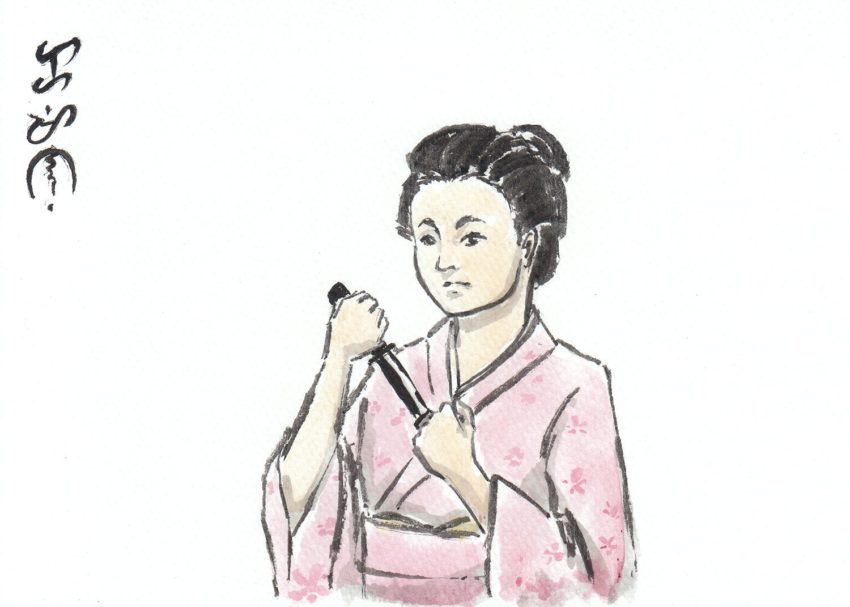When you think of feudal Japan, what are the first things that come to mind? Usually it’s the honorable samuraiSAMURAI 侍 "warrior serving a lord" learn more..., wielding his elegant katanaKATANA 刀 "sword" learn more..., able to cut through man and metal alike. The lore surrounding this iconic warrior continues to capture the imagination of all ages, ranging across cultures and media from books to blockbuster movies. But a lesser-known blade utilized at this time was the Japanese short sword. Its use dates all the way back to the 15th century.
But before we get in-depth about short swords, we need to travel back to ancient Japan to explore the history behind the blade.
First Japanese Long Blades: Chokuto and Tachi
The oldest swords on record in Japan are imported blades from China dating from 280 B.C. Many scholars believe that the art behind forging the steel sword came from China as well as Korea, but the details behind it remain unknown. What historians do know is that by the 6th century A.D., single-edged straight blades called chokutoCHOKUTO 直刀 "straight sword" learn more... were being forged by Japanese blacksmiths en masse.
The production of these blades lasted until the 8th century A.D., in the Heian Era, when technological advancements in warfare revolutionized the field of battle from primarily infantry-based combat to cavalry. Blades needed to be forged in a way to accommodate these changes in warfare. Once-straight single-edged swords became curved single-edged swords called tachiTACHI 太刀 "great sword" learn more..., forged in a way that gave them a hard outer surface with a soft core.
The Birth of the Shorter Katana
Masamune, recognized as Japan’s greatest swordsmith, also lived during this time; his have become some of Japan’s most legendary swords. The tachi was improved upon by marginally increasing the width of the blade. Aesthetics were one of the most important considerations in the creation of the blade and most blades were signed by their artisan. Masamune understood the inherent weaknesses present in blades of the time and worked on improving them so they could take a keen edge without breaking. Both he and others used a four metal bar system to protect the sword’s blade. One soft iron bar protected it from breaking and two hard iron bars kept the steel in place. The fourth steel bar was to be sharpened.
The Muromachi Era, spanning from the late 14th century to the late 16th century, was one marked by a civil war that spanned for nearly a hundred years. The struggle for power meant that both sides formed massive armies, which demanded mass production of the sword, referred to as kazuuchimonoKAZUUCHIMONO 数打物 "mass-produced things" learn more....
Tachi were still produced, but the era of the katana began during this time. The katana was the chosen weapon of the samurai, as they were shorter than the tachi, which made it easier to draw when fighting in hand-to-hand combat. They were so important to the soldier that on his deathbed, his katana would be placed by his side.
The Wakizashi: A Classic Japanese Short Sword
In traditional Japanese swordcraft, a wakizashi is any short Japanese blade between 12 and 24 inches.
Wearing the wakizashi alongside the longer katana marked the wielder as a samurai or landed swordsman in Japanese society. The tradition of wearing both a katana and wakizashi is known as daito in Japanese tradition, which translates roughly into English as “big-little”.
The wakizashi was important in samurai ceremony and ritual, its shorter blade useful for beheading surrendering opponents and prisoners and exchanging during surrender to enemy officers. It was also used as a Japanese suicide sword for anyone needing to commit ritual suicide (seppukuSEPPUKU 切腹 "cutting the stomach" learn more...).
Though spears and bows were used more often in outdoor skirmishes on horseback, the wakizashi was a formidable weapon in its own right, generally used in close-quarters or indoor engagements due to their relative shortness when compared with other swords in the samurai’s arsenal.
The Short Wakizashi By Itself
Carried alone without a katana, the wakizashi often identified one as a member of the merchant rather than samurai class. As civil wars ravaged the countryside, attacks on merchant caravans became increasingly common. Merchants often openly wore wakizashi (in addition to other assorted weapons) in order to discourage predatory behavior from bandits and enemy samurai.
Symbols on both the Japanese short sword wakizashi and the Japanese katana often denoted the qualities of the wielder and his family. Highly unusual variants have emerged at antique exhibitions, some of which feature crests of famous families throughout Japanese history. Included are such illustrious names as Tokugawa, the powerful clan who ruled Japan between 1603 and 1867.
The wakizashi was central to the ceremony of ritual suicide, known as seppuku, where the blade was used to make a large laceration in one’s own gut before another swordsman severed the head. Seppuku was committed as an honorable act to redeem oneself after a great display of shame, such as losing a battle, being captured by the enemy or being found guilty of an especially heinous crime.
To this day in Japan, suicide is all too often committed by businessmen and other people in high-pressure environments where everything is on the line, though the practice is discouraged by mainstream modern Japanese society.
The Tanto: Short Swords for Quick Stabbing
TantoTANTO 短刀 "short sword" learn more..., which literally translates into “short sword,” were also worn by samurai in historical Japan. You might have heard the term before in western cutlery stores, where western manufacturers create knives with a “tanto edge,” but while nice these are not true Japanese tanto.
The short blades of tanto are designed for piercing and stabbing and they perform their tasks well. This explains why knife makers from other cultures have adopted the technology over time.
This type of Japanese short sword was often carried by Japanese women as a self-defense weapon throughout history as they could be much more easily concealed when compared to longer blades.
Tantojutsu is a school of martial arts dedicated specifically to the use of tanto and similar knives.
The Kaiken: Ornamental Double-Edged Daggers
KaikenKAIKEN 懐剣 "chest dagger" learn more..., a variation of the tanto used also by women throughout Japanese history, are double-edged daggers with beautiful, ornamental fittings.
Kaiken were actually not exclusively used by women, but they were valued for how easily they were concealed within a kimono for indoor engagements where the slightly longer Japanese short sword wakizashi would not make as much sense. Kaiken were prized, for example, in close-quarters combat.
Inside of the kimono, the kaiken was concealed either in a pocket called a futokoro or a sleeve called a tamoto.
Like the wakizashi, kaiken were used during ritual suicide. Instead of piercing the stomach, the person committing seppuku would slash open the veins in the side of the neck using the sharp razor edge of the small but deadly kaiken.
The Shikomizue: Hidden Short Swords for Assassins
ShikomizueSHIKOMIZUE 仕込み杖 "placing inside a cane" learn more..., or cane swords, came in various lengths depending upon the height of the user as well as how the weapon was intended to be concealed. They were commonly used in assassinations throughout Japanese history, as the blade is easily disguised as a cane, baton or walking stick. The world-famous ninja were especially drawn to the dark powers of shikomizue, though modern buyers often have one or more beautiful examples in their own collections.
Shorter varieties of the shikomizue were made particularly for clandestine missions where there wasn’t a lot of room to conceal the weapon, or where it was suspected inventories would be over-scrutinized.
Many sword-hunts were undertaken throughout Japanese history, wherein officials confiscated weapons from the populace. Even members of the samurai class were divested of their implements for varying reasons. During the Meiji Restoration, when swords were prohibited for most Japanese, the shikomizue reigned supreme, carried in concealment by both regular people and by criminals who feared being deprived of their weaponry.
Which Japanese Short Sword Should You Get?
If you’re looking to add a short sword with beautiful and detailed Japanese workmanship to your collection, you have several options to choose from. You can try to get one of each type listed on this page, or you could pick your favorite and wait for the perfect example to speak to you. Classic, authentic older blades may be available from time to time but will cost quite a bit more. Newly-produced short swords can be every bit as beautiful as the weapons of old, and will glisten and shine and dominate anywhere they’re displayed.
If you already have one or more long swords but no short ones, it may be time for you to explore the more subtle but just as lethal world of Japan’s short sword traditions.

